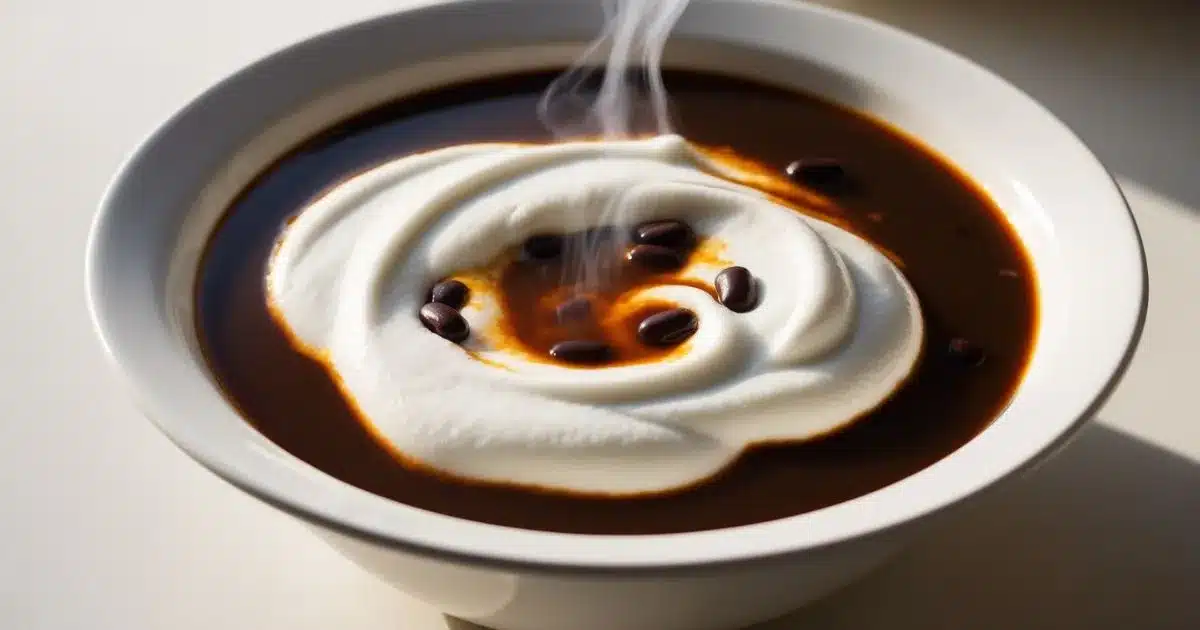What is the White Stuff in Goya Black Bean Soup?
What is the white stuff in Goya black bean soup? This is a common question, and the answer can vary depending on the situation. This article dives into 7 essential secrets to understand the white residue, foam, or film you might find in your black bean soup, addressing its causes and whether it’s something to worry about.
Understanding the Mystery of the White Stuff
Finding unexpected white residue in your favorite black bean soup can be unsettling. It’s crucial to understand what this substance is to determine if it’s safe to consume and how to prevent it in the future. Let’s explore the common culprits behind this phenomenon.
The Primary Suspect: Starch
The most frequent cause of white stuff in black bean soup is starch. Black beans are naturally rich in starch. During the cooking process, especially when boiling, the starch granules are released into the water.
As the soup cools, the starch can settle and form a white, cloudy appearance or a thin film on the surface. This is especially noticeable in canned soups or those left to sit for a while.
The Role of Proteins and Saponins
Besides starch, proteins and saponins contribute to the white substance. Saponins are natural compounds found in beans that can create a foamy appearance when cooked.
The proteins in the beans can also coagulate and contribute to the cloudy appearance, especially during processing and heating. These components are natural and generally harmless.
Minerals and Hard Water
Hard water, which contains high levels of minerals such as calcium and magnesium, can react with the components in black beans. This reaction can sometimes lead to the formation of a white precipitate or film.
Using filtered water can help reduce the likelihood of this occurring. This is particularly important if you notice the white stuff frequently in your home-cooked soups.
Processing Methods: Canned vs. Homemade
The likelihood of encountering the white substance varies between canned and homemade soups. Canned soups undergo different processing methods that can increase the visibility of starch and proteins.
Homemade soups, on the other hand, allow for more control over the ingredients and cooking process, potentially reducing the formation of the white residue.
Spoilage: Recognizing the Signs
While starch, proteins, and minerals are common harmless causes, it’s essential to rule out spoilage. Spoilage is a less common cause of white stuff in black bean soup, but a crucial one to consider.
If the white substance is accompanied by an off odor, a sour taste, or any signs of mold, the soup should be discarded immediately. Food safety is paramount.
Minimizing the White Stuff in Your Soup
Several steps can be taken to reduce the amount of white stuff in your black bean soup. These steps range from rinsing your beans thoroughly before cooking to adjusting your cooking methods.
Rinsing and Soaking Beans
Before cooking dry black beans, rinse them thoroughly under cold water. This removes excess starch and other surface impurities. Soaking the beans for several hours or overnight further helps release starches and saponins, reducing their presence in the final soup.
Skimming the Foam During Cooking
During the cooking process, a foamy layer may form on the surface. This foam primarily consists of saponins and released proteins. Skimming this foam off the top of the soup can help minimize the white residue in the finished product.
Using Filtered Water
As mentioned earlier, using filtered water reduces the mineral content, minimizing potential reactions that contribute to the white substance. This is especially effective if you have hard water in your area.
Adjusting Cooking Times
Overcooking the beans can lead to excessive starch release. Adjust your cooking times to ensure the beans are cooked through but not overly soft. This can help prevent the excessive formation of white residue.
Cooling and Storage Techniques
Proper cooling and storage techniques can also impact the appearance of the soup. Allow the soup to cool completely before refrigerating it. Store it in airtight containers to prevent excessive moisture and condensation, which can contribute to the formation of a white film.
Is the White Stuff Safe to Eat?
Generally, the white stuff caused by starch, proteins, or minerals is safe to consume. It doesn’t pose a health risk. However, if you suspect spoilage, err on the side of caution and discard the soup.
Always use your senses to assess the quality of your food. Smell, look, and taste a small amount before consuming the entire batch.
Preventing Future Occurrences
To avoid the appearance of the white stuff in your future black bean soups, consider incorporating the previously mentioned techniques. Rinsing and soaking, skimming the foam, using filtered water, and adjusting cooking times can all make a significant difference.
Furthermore, if you are using canned soups, you can try draining and rinsing the beans before adding them to the soup.
Black Bean Soup Nutrition and Benefits
Beyond understanding the white substance, it’s essential to appreciate the nutritional benefits of black bean soup. Black beans are an excellent source of protein, fiber, and various vitamins and minerals.
Including black bean soup in your diet can contribute to improved digestion, heart health, and overall well-being. It is also a versatile and delicious dish that can be customized to suit various dietary preferences.
Amazing Culinary Uses
Black bean soup isn’t just a standalone dish. Its versatility allows for incredible culinary creativity. It can be a base for stews, a filling for enchiladas, or even a unique sauce for grilled meats.
Experimenting with different spices and toppings can elevate the flavor profile and make it a staple in your kitchen. Its adaptable nature makes it a wonderful addition to any recipe collection.
Essential Recipe Tips
To make the best black bean soup, follow these essential recipe tips:
-
Use high-quality ingredients: Fresh spices and good-quality beans make a noticeable difference.
-
Sauté aromatic vegetables: Onions, garlic, and peppers add depth of flavor.
-
Simmer slowly: Allow the flavors to meld together by simmering the soup gently.
-
Adjust seasoning: Taste and adjust the seasoning throughout the cooking process.
-
Add acidity: A splash of lime juice or vinegar brightens the flavors.
Following these tips will ensure a flavorful and satisfying bowl of black bean soup every time.
Goya Black Bean Soup: A Staple
Goya black bean soup is a convenient and popular choice for many. Understanding its ingredients and preparation methods can help you enjoy it even more.
Knowing what to expect and how to handle common occurrences like the white stuff ensures a positive culinary experience. By taking proactive steps, you can make the most of this versatile and nutritious soup.
Exploring Variations and Add-ins for Goya Black Bean Soup
One of the best things about Goya Black Bean Soup is how easily you can personalize it. While it’s delicious on its own, adding different ingredients and flavors can transform it into a unique and exciting meal. Let’s explore some fantastic options:
Flavor Enhancers
Consider adding these to boost the flavor:
-
Spices: Cumin, smoked paprika, chili powder, oregano, and coriander.
-
Herbs: Fresh cilantro, parsley, or a bay leaf during cooking.
-
Acids: A squeeze of lime juice, a dash of vinegar, or a spoonful of sour cream.
-
Heat: A pinch of cayenne pepper, a few drops of hot sauce, or a diced jalapeño.
Textural Elements
To add some texture, consider these:
-
Crunchy Toppings: Tortilla strips, toasted pepitas (pumpkin seeds), or crumbled cotija cheese.
-
Creamy Additions: A dollop of Greek yogurt, avocado slices, or a swirl of coconut milk.
-
Vegetable Boosts: Diced bell peppers, corn kernels, or roasted sweet potatoes.
Protein Power-Ups
Adding protein makes the soup even more satisfying:
-
Shredded Chicken or Pork: Leftover rotisserie chicken or pulled pork works great.
-
Blackened Shrimp: Adds a smoky, spicy kick.
-
Hard-Boiled Eggs: Chopped and sprinkled on top.
-
Tofu or Tempeh: For a vegetarian boost, try crumbled tofu or tempeh.
Troubleshooting Common Issues with Black Bean Soup
Even with the best intentions, sometimes things don’t go as planned. Here are some common problems and how to fix them:
Soup is Too Thick
If your soup is too thick, add more broth or water until you reach your desired consistency. Stir well and simmer for a few minutes to allow the flavors to meld.
Soup is Too Thin
If your soup is too thin, simmer it uncovered for a longer period to allow some of the liquid to evaporate. Alternatively, you can blend a small portion of the soup and stir it back in to add body.
Soup is Bland
If your soup lacks flavor, add more seasoning. Start with salt and pepper, and then experiment with different spices and herbs until you achieve the desired taste. Don’t be afraid to add a touch of acidity to brighten the flavors.
Soup is Too Salty
If your soup is too salty, add a splash of vinegar or lime juice to balance the flavors. You can also add a potato cut into large chunks, simmer it for about 15 minutes, and then remove it. The potato will absorb some of the excess salt.
Beans are Undercooked
If your beans are still hard, continue to simmer the soup until they are tender. Add more liquid if necessary to prevent the soup from drying out.
What is the White Stuff in Goya Black Bean Soup? The Ultimate Conclusion
So, what is the white stuff in Goya black bean soup? In most cases, it’s a harmless combination of starch, proteins, and minerals. Understanding this allows you to enjoy your soup with confidence.
By following the preventative measures and being mindful of the signs of spoilage, you can ensure that your black bean soup experience is always safe and enjoyable.
FAQ
What is the white stuff in canned black beans?
The white stuff in canned black beans is usually starch released during the canning process. It can also be coagulated proteins or minerals from the water. It’s generally safe to eat.
What is the white stuff in my soup?
The white stuff in your soup could be starch, proteins, or minerals that have separated during cooking or storage. Spoiled soup can also have some white mold or discoloration, so smell it to check.
What is the white foam in black beans?
The white foam in black beans is primarily saponins, natural compounds found in beans. They release when the beans are cooked and are typically harmless. Skimming the foam off can reduce it.
Why do my beans have white stuff?
Your beans might have white stuff due to starch release, mineral deposits from hard water, or proteins coagulating during cooking. These are often benign and safe to consume.



